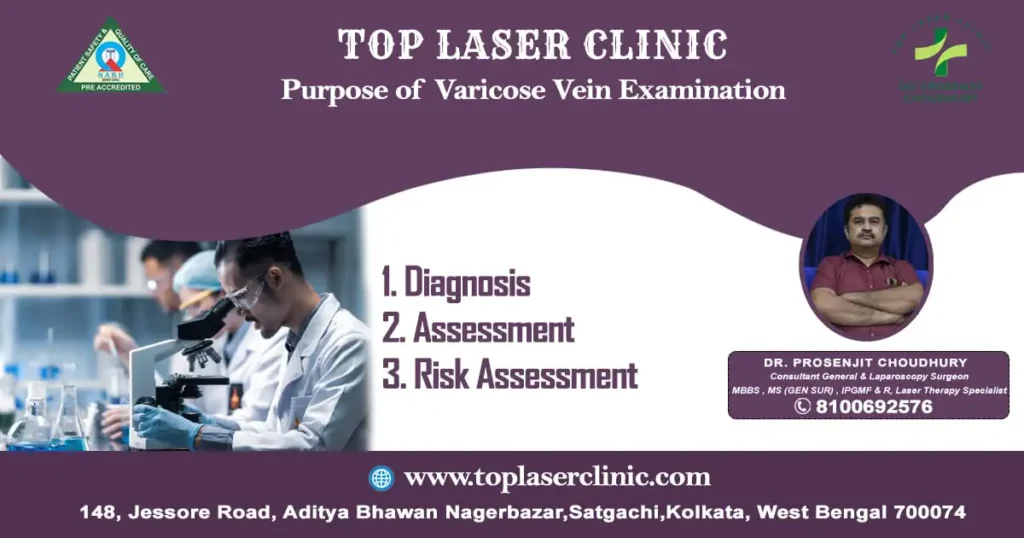
Table of Contents
Millions of people worldwide suffer from the widespread vascular ailment known as varicose veins. These enlarged and twisted veins often appear on the legs and can cause discomfort, pain, and cosmetic concerns. If you suspect you have varicose veins or have been referred by a healthcare professional for an examination, it’s important to understand what to expect during the examination process.
In this blog post, we’ll walk you through the varicose vein examination, including its purpose, methods, and what you can do to prepare.
Purpose of Varicose Vein Examination
A varicose vein examination serves several important purposes:
- Diagnosis: The primary purpose of the examination is to confirm whether you have varicose veins or another vascular condition. Planning a treatment strategy that works requires an accurate diagnosis.
- Assessment: The examination helps assess the severity and extent of your varicose veins. This information guides treatment decisions and helps your healthcare provider determine the best approach for managing your condition.
- Risk Assessment: Varicose veins can lead to complications such as venous ulcers or blood clots. This varicose vein examination helps assess your risk for these complications.
Methods of Varicose Vein Examination
The examination for varicose veins typically involves the following steps:
1. Medical History:
Your healthcare provider will begin by asking you about your medical history, including any family history of varicose veins, previous vein-related issues, or other relevant medical conditions.
2. Physical Examination:
A physical examination is performed to assess the appearance of your veins, identify any swelling or skin changes, and check for signs of complications. You may be asked to stand, sit, and lie down during this examination to observe how your veins respond to different positions.
3. Photoplethysmography (PPG):
PPG is another non-invasive test that measures blood flow and can help identify issues with blood circulation in the affected veins.
4. Venous Reflux Exam:
This test is used to check for venous reflux, a condition where blood flows backward in the veins due to valve dysfunction. It involves measuring the direction of blood flow in the veins using ultrasound.
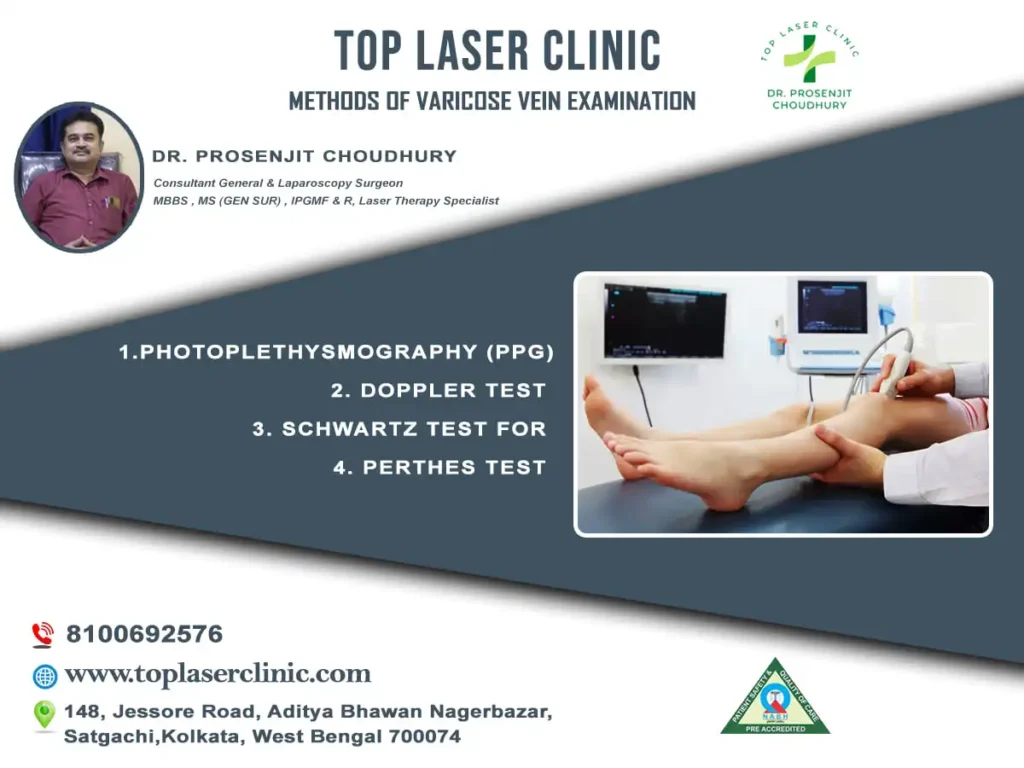
5. Other Tests:
Depending on your specific case, your healthcare provider may recommend additional tests such as CT scans or MRI to get a comprehensive view of your veins.
6. Doppler test for varicose vein:
To diagnose and treat varicose veins effectively, healthcare professionals need a clear picture of the venous system’s functionality. This is where the Doppler test comes into play. The Doppler test, also known as a Doppler ultrasound or duplex ultrasound, is a painless, non-invasive procedure that uses high-frequency sound waves to create images of blood flow through the veins. Here’s how it works:
- Sound Waves: A handheld device called a Doppler probe emits high-frequency sound waves. These waves are directed toward the area being examined, usually the legs.
- Sound Wave Reflection: The sound waves bounce off the blood cells in the veins and return to the Doppler probe.
- Data Analysis: A computer processes the reflected sound waves and creates real-time images of the blood flow. These images show both the direction and speed of blood flow within the veins.
- Color Coding: In addition to the visual images, the Doppler test often color-codes blood flow to make it easier to interpret. Typically, blue indicates blood flowing away from the probe (normal venous flow), while red represents blood moving toward the probe (indicating potential issues with valve function).
Advantages of Doppler Testing
- Accurate Diagnosis: Doppler testing provides detailed information about the structure and function of veins, allowing healthcare professionals to pinpoint the location and severity of varicose veins.
- Non-Invasive: Unlike older diagnostic methods, such as venography (a contrast dye test), Doppler testing is non-invasive and doesn’t require the injection of contrast agents.
- Real-Time Feedback: The real-time imaging provided by Doppler testing allows for immediate assessment and can guide treatment decisions.
- Safe and Painless: Patients experience no discomfort during the procedure, and it carries minimal risks or side effects.
Treatment Options
Once varicose vein examination were done through Doppler testing, healthcare providers can recommend appropriate treatment options. These may include lifestyle changes, compression stockings, or minimally invasive procedures such as endovenous laser therapy (EVLT) or radiofrequency ablation (RFA). Surgical intervention can be required in extreme circumstances.
The Doppler test for varicose veins has revolutionized the diagnosis and management of this common vascular condition. Its non-invasive nature, accuracy, and real-time imaging make it an invaluable tool in the hands of healthcare professionals.
If you suspect you have varicose veins or are experiencing symptoms such as pain, swelling, or skin changes in your legs, don’t hesitate to consult a healthcare provider who can guide you through the diagnostic process, which may include the Doppler test, and recommend appropriate treatment options. Remember, early detection and intervention can help you enjoy a healthier and more comfortable life.
7. Schwartz test for varicose vein:
The Schwartz Test, also known as the tourniquet test or the tourniquet sign, is a straightforward diagnostic tool used by healthcare professionals to evaluate the presence and severity of varicose veins. It is a non-invasive procedure that can be performed in a clinical setting and does not require any special equipment.
How Does the Schwartz Test Work?
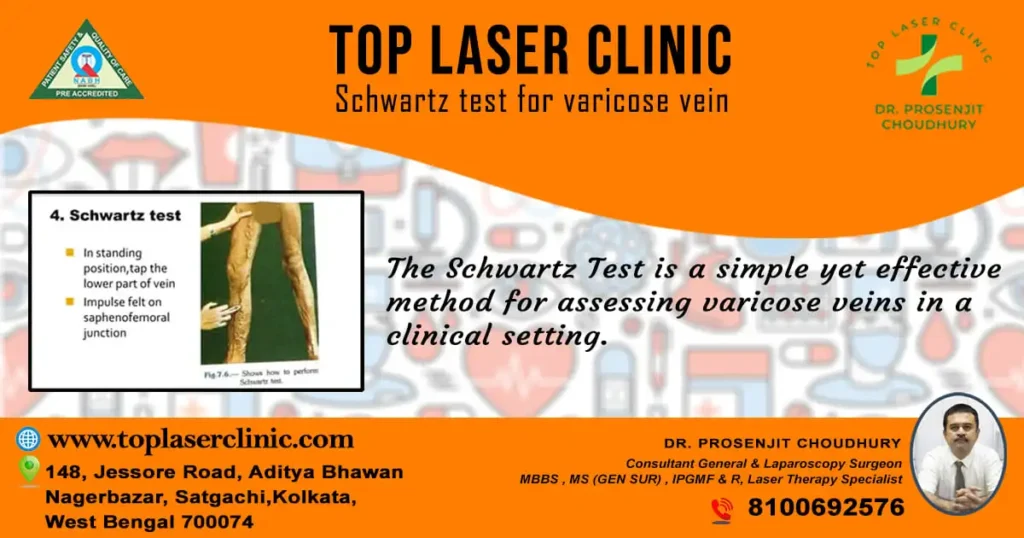
The Schwartz Test involves the following steps:
- Patient Preparation: The patient should be comfortably seated or lying down, with the legs exposed.
- Examination: The healthcare provider visually inspects the legs for any visible varicose veins or spider veins. This initial assessment helps determine the location and extent of the condition.
- Blood Pressure Cuff Application: A blood pressure cuff is placed around the patient’s thigh, typically in the upper thigh or groin area, and inflated to a pressure slightly above the patient’s systolic blood pressure.
- Observe for Varicose Veins: While the cuff is inflated, the healthcare provider watches for any varicose veins or spider veins that become more prominent or visible. This is usually a sign that the veins are under increased pressure, which is indicative of venous insufficiency.
- Release the Cuff: The blood pressure cuff is slowly deflated, and the healthcare provider observes if the varicose veins or spider veins disappear or diminish in size as the pressure decreases.
Significance of the Schwartz Test
The Schwartz Test is a valuable tool in assessing varicose veins for several reasons:
- Quick and Non-Invasive: It provides a rapid assessment of varicose veins without the need for invasive procedures or special imaging.
- Diagnostic Aid: While it is not a definitive diagnostic tool, the test can help healthcare providers identify potential areas of concern that may require further evaluation, such as ultrasound imaging.
- Monitoring Progress: The test can be used to track changes in the appearance and severity of varicose veins over time, helping healthcare providers assess the effectiveness of treatment.
- Patient Education: The Schwartz Test allows patients to visually observe the impact of increased pressure on their varicose veins, helping them better understand their condition and the importance of managing it.
The Schwartz Test is a simple yet effective method for assessing varicose veins in a clinical setting. While it may not provide a definitive diagnosis on its own, it serves as a valuable diagnostic aid that can guide healthcare providers in evaluating the presence and severity of varicose veins.
If you suspect you have varicose veins or are experiencing symptoms such as leg pain or swelling, consult a healthcare professional for a comprehensive evaluation and appropriate treatment options. Early detection and management can help improve the quality of life for individuals with varicose veins.
8. Perthestest for varicose vein:
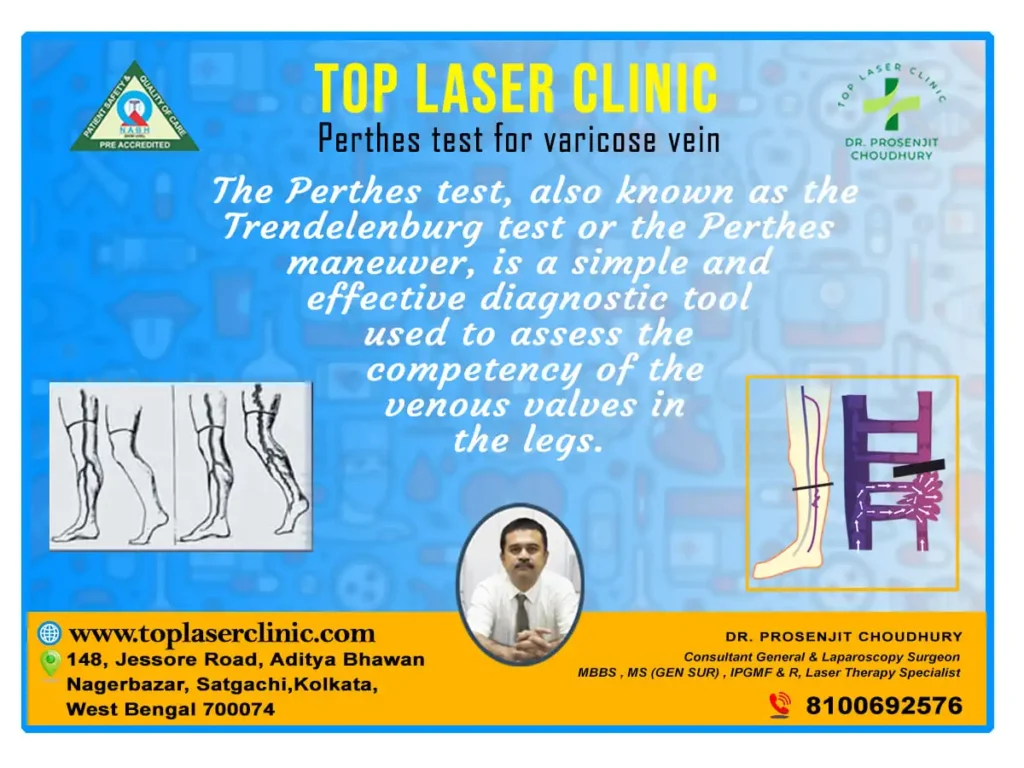
The Perthes test, also known as the Trendelenburg test or the Perthes maneuver, is a simple and effective diagnostic tool used to assess the competency of the venous valves in the legs. Venous valves are crucial for ensuring proper blood flow in the veins and preventing blood from flowing backward. When these valves malfunction, it can lead to conditions like varicose veins.
What Does the Perthes Test Reveal ?
The Perthes test primarily helps in diagnosing venous insufficiency, which is a common underlying cause of varicose veins. Venous insufficiency occurs when the valves in the veins fail to prevent the backflow of blood, leading to increased pressure in the veins and the development of varicose veins.
The results of the Perthes test can provide valuable information to healthcare professionals about the extent of venous insufficiency and help guide treatment decisions. Based on the test results, treatment options may include lifestyle modifications, compression stockings,minimally invasive procedures like endovenous laser treatment (EVLT) or radiofrequency ablation (RFA), or in more severe cases, surgical intervention.
The Perthes test is a valuable tool in the evaluation of varicose veins and can help identify underlying venous insufficiency. If you’re experiencing symptoms of varicose veins or are concerned about your vascular health, consult a healthcare professional who can perform the Perthes test and provide guidance on appropriate treatment options.
Remember that early diagnosis and intervention can often prevent the progression of varicose veins and improve your overall vascular health.
The Perthes test involves the following steps:
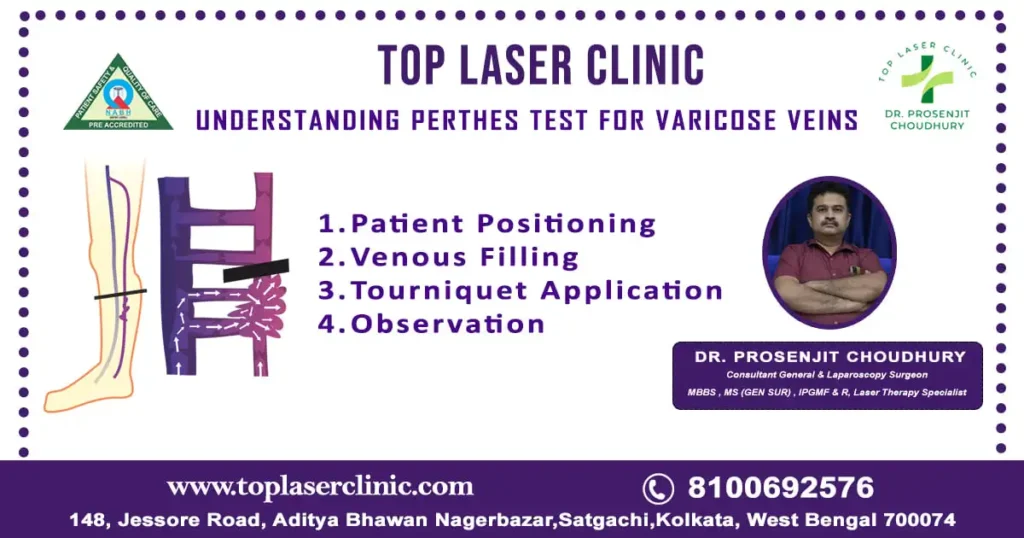
- Patient Positioning: The patient is typically asked to lie flat on their back on an examination table. The legs are elevated to a 45-degree angle.
- Venous Filling: The physician will then gently compress the patient’s upper thigh to empty the superficial veins.
- Tourniquet Application: A tourniquet, which is essentially a tight band or cuff, is applied to the upper thigh, just below the inguinal ligament (the crease where the thigh meets the abdomen).
- Observation: The physician will observe the behavior of the veins in the lower leg. If the venous valves are functioning properly, the veins should remain empty. If the valves are faulty, blood may flow backward, filling the superficial veins and indicating venous insufficiency.
Preparing for the Examination:
To ensure a successful varicose vein examination, here are some steps you can take to prepare:
- Bring Medical Records: If you have any relevant medical records, previous test results, or a list of medications you’re currently taking, bring them with you to the appointment.
- Wear Comfortable Clothing: Dress in loose-fitting, comfortable clothing that allows easy access to the affected areas, typically the legs.
- Stay Hydrated: Drinking enough water can help improve the visibility of your veins during the examination.
- Ask Questions: Don’t hesitate to ask your healthcare provider any questions you may have about the examination process or your varicose vein condition.
A varicose vein examination is a crucial step in diagnosing and managing this common vascular condition. By understanding the purpose of the examination and what to expect during the process, you can be better prepared to discuss your condition with your healthcare provider and explore treatment options if necessary. Remember, early diagnosis and intervention can help alleviate symptoms and prevent potential complications associated with varicose veins.